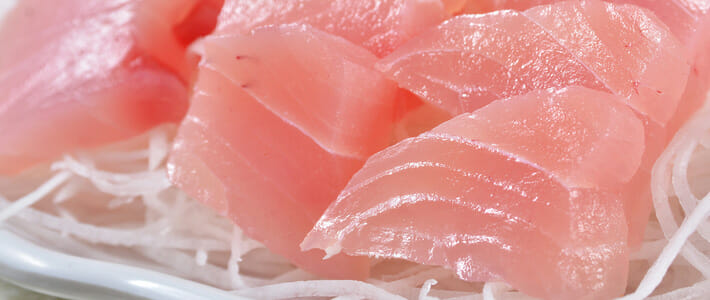Swordfish
Swordfish is distinguished by its pointed sword that constitutes about one-third of its body length. This species has a sleek body in dark, metallic blue-gray colors and can grow up to 15 feet.
Consumers recognize this species as a dining favorite, a fact that is reflected in its high and fluctuating prices.
Product pdf for download-
3.5 oz (100g) raw edible portion
-
Calories 152
-
Calories from Fat 41
-
Potassium 362mg
-
Cholesterol 47mg/16%
-
Sodium 117mg/5%
-
Carbohydrates 0
-
Protein 26g
-
Total Fat 5/8%
Interesting Fact
Chile first discovered this seabass and called it “Bacalao de profundidad” or “cod of the depths.”
Alternative
Popular alternatives to swordfish are Mako shark, marlin and tuna.
Source
Swordfish is harvested worldwide in deep temperate and tropical seas. Singapore and Japan are best known for their quality of frozen swordfish, while Canada, the U.S. and Chile have the best reputation for fresh swordfish.
Flavor/Texture
Swordfish meat is moist with a meaty flavor, and is dense, lean and firm. Swordfish cooked meat is ivory colored.
Market Segments
Swordfish is appropriate in the casual dining, fine dining, hotel, and resort/club segments of the market.
Harvest Method
The majority of swordfish is harvested through one of two ways: longlining and gillnetting. In longlining, the boats set baited hooks on a line which run 30-40 miles during the Full Moon so the swordfish can see the bait. In gillnetting, the actual gillnet ranges from one half mile to one mile long, and is 300 feet deep. The net boats fish the dark side of the moon, so that the fish don’t see the nets. Swordfish are also sometimes harpooned.
Harvest Season
Swordfish are available year-round, though its peak season is the summer.
Quality Control
Swordfish accumulate mercury naturally occur-ring in the ocean, so levels in fish imported into the U.S. are routinely monitored. Also, some fish carry parasitic worms in the flesh, although harmless, they should be cut out. Proper handling of swordfish determines its quality. Thus, it is important to retrieve the fish quickly, immediately bleeding, gutting, heading, and packing it on ice. The belly cavity should be stuffed with ice in order to prevent the center of the fish to become heated. In addition, the swordfish should always be packed with its belly up or the mat will turn brown.
Preparation
Swordfish is most commonly prepared by marinating, grilling, baking, pan-frying, or smoking the pieces, or using on kebabs.
